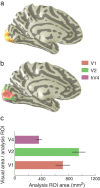Attentional modulation of fMRI responses in human V1 is consistent with distinct spatial maps for chromatically defined orientation and contrast
- PMID: 21900568
- PMCID: PMC3292779
- DOI: 10.1523/JNEUROSCI.0580-11.2011
Attentional modulation of fMRI responses in human V1 is consistent with distinct spatial maps for chromatically defined orientation and contrast
Abstract
Attending to different stimulus features such as contrast or orientation can change the pattern of neural responses in human V1 measured with fMRI. We show that these pattern changes are much more distinct for colored stimuli than for achromatic stimuli. This is evidence for a classic model of V1 functional architecture in which chromatic contrast and orientation are coded in spatially distinct neural domains, while achromatic contrast and orientation are not.
Figures




Similar articles
-
Orientation-selective chromatic mechanisms in human visual cortex.J Vis. 2010 Oct 29;10(12):34. doi: 10.1167/10.12.34. J Vis. 2010. PMID: 21047766
-
fMRI representational similarity analysis reveals graded preferences for chromatic and achromatic stimulus contrast across human visual cortex.Neuroimage. 2020 Jul 15;215:116780. doi: 10.1016/j.neuroimage.2020.116780. Epub 2020 Apr 8. Neuroimage. 2020. PMID: 32276074
-
Attention Determines Contextual Enhancement versus Suppression in Human Primary Visual Cortex.J Neurosci. 2015 Sep 2;35(35):12273-80. doi: 10.1523/JNEUROSCI.1409-15.2015. J Neurosci. 2015. PMID: 26338337 Free PMC article.
-
Population encoding of spatial frequency, orientation, and color in macaque V1.J Neurophysiol. 1994 Nov;72(5):2151-66. doi: 10.1152/jn.1994.72.5.2151. J Neurophysiol. 1994. PMID: 7884450
-
Functional analysis of primary visual cortex (V1) in humans.Proc Natl Acad Sci U S A. 1998 Feb 3;95(3):811-7. doi: 10.1073/pnas.95.3.811. Proc Natl Acad Sci U S A. 1998. PMID: 9448245 Free PMC article. Review.
Cited by
-
Neuro-cognitive mechanisms of conscious and unconscious visual perception: From a plethora of phenomena to general principles.Adv Cogn Psychol. 2011;7:55-67. doi: 10.2478/v10053-008-0090-4. Epub 2011 Dec 1. Adv Cogn Psychol. 2011. PMID: 22253669 Free PMC article.
-
Mixing of Chromatic and Luminance Retinal Signals in Primate Area V1.Cereb Cortex. 2015 Jul;25(7):1920-37. doi: 10.1093/cercor/bhu002. Epub 2014 Jan 23. Cereb Cortex. 2015. PMID: 24464943 Free PMC article.
-
Human V4 Activity Patterns Predict Behavioral Performance in Imagery of Object Color.J Neurosci. 2018 Apr 11;38(15):3657-3668. doi: 10.1523/JNEUROSCI.2307-17.2018. Epub 2018 Mar 8. J Neurosci. 2018. PMID: 29519852 Free PMC article.
-
Pattern reversal chromatic VEPs like onsets, are unaffected by attentional demand.Vis Neurosci. 2024 Dec 16;41:E006. doi: 10.1017/S0952523824000063. Vis Neurosci. 2024. PMID: 39676579 Free PMC article.
References
-
- Anstis SM, Cavanagh P. A minimum motion technique for judging equiluminance. In: Mollon JD, Sharpe LT, editors. Colour vision: physiology and psychophysics. London: Academic; 1983. pp. 156–166.
-
- Brainard DH. Calibration of a computer controlled color monitor. Color Res Appl. 1989;14:23–34.
-
- Brainard DH. The psychophysics toolbox. Spat Vis. 1997;10:433–436. - PubMed
-
- Brewer AA, Liu J, Wade AR, Wandell BA. Visual field maps and stimulus selectivity in human ventral occipital cortex. Nat Neurosci. 2005;8:1102–1109. - PubMed
Publication types
MeSH terms
Grants and funding
LinkOut - more resources
Full Text Sources
